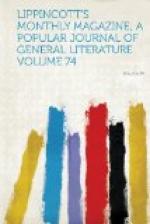The Middle Temple Library, a handsome building of recent erection, situated on the river side of the Inn, at the southwest corner of the Temple Gardens, was opened by the Prince of Wales, October 31, 1861. While it is of nobler proportions than the library of the Inner Temple, it does not seem to be so well suited for the purposes of the student. Its location, however, is far more pleasant, on the margin of the flower-mantled garden, and within sight of the busy Victoria Embankment and of the panoramic river scenery. From the great oriel window a noble vista is unrolled. In the distance, the twin-towered Houses of Parliament are outlined against the sky, while the massive proportions of the “water front” of Somerset House, the motley groupings of the structures that crowd the intervening water-side, and the flashing river hound by many-arched bridges, fill the middle distance.
Aside from the lustre shed around its history by many eminent lawyers and jurists, the Middle Temple has numbered among its students several great poets and dramatists, notably John Ford, William Congreve, Nicholas Rowe, Thomas Shadwell, Richard Brinsley Sheridan, and Thomas Moore. But, as their literary remains prove, few or none of them prosecuted their legal studies with that sedulous devotion which the law, proverbially a jealous mistress, demands. Sir William Blackstone, who immortalized his name by his “Commentaries on the Laws of England,” was educated in the Middle Temple, where he was entered as a student, November 20, 1741, and by which he was called to the bar, April 26, 1750. In his Temple chambers, ere he finally consecrated his massive intellect to the legal profession, Blackstone wrote the famous “Farewell to the Muses:”
Lull’d by
the lapse of gliding floods,
Cheer’d
by the warbling of the woods,
How blest my days,
my thoughts how free,
In sweet society
with thee!
Then all was joyous,
all was young,
And years, unheeded,
roll’d along;
But now the pleasing
dream is o’er,—
These scenes must
charm me now no more.
Lost to the field
and torn from you,
Farewell! a long,
a last adieu.
Edmund Burke was entered at the Middle Temple in 1747, and kept his terms in 1750. But the great tribune was never called to the bar. Had he been, what a powerful advocate, what a pitiless adversary, he would have made! Porson, the brilliant but bibulous classicist, has left behind him many sad stories of his pranks during his residence in Essex Court, where he had chambers immediately above those occupied by the future Baron Gurney, whom, in one of his debauches, he came near burning in his bed. Chaucer is believed to have entered as a student of the Middle Temple, where he is supposed to have formed a friendship with the “moral Gower.” Sir Walter Raleigh, Sir Thomas Overbury, Sir Edward Bramston, Lord-Keeper Guildford, Edmund Plowden,—perhaps the greatest lawyer of the Elizabethan epoch, —“Ugly” Dunning, who afterward became Lord Ashburton, and Lord Eldon, are among the ornaments of the British bench and bar who sprung from the Middle Temple.




